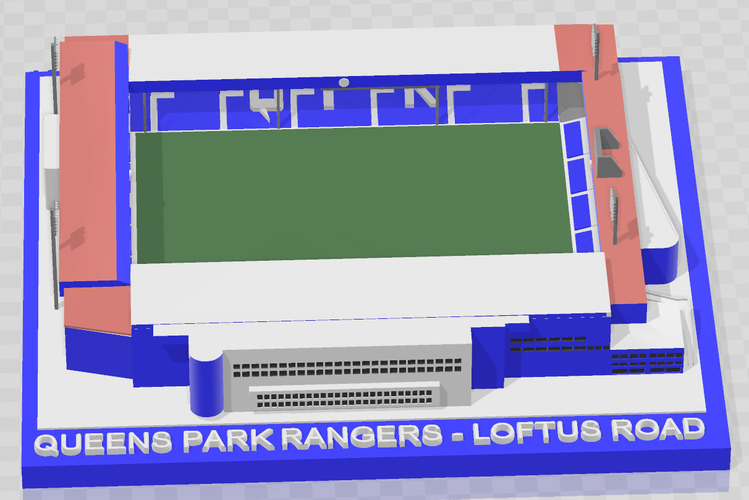
QPR - Loftus Road
pinshape
The ground was first used on October 11, 1904, by Shepherd's Bush F.C., a now-defunct amateur side that ceased to exist during the First World War. Queens Park Rangers moved to Loftus Road in 1917 after having their Park Royal ground commandeered by the army in 1915. At that time, the ground was an open field with a pavilion and one stand from Park Royal was dismantled and re-erected as the Ellerslie Road stand in 1919. This stand remained the only covered seating area until 1968 when it was replaced in 1972. It had a capacity of 2,950. The stadium's highest recorded attendance of 35,353 occurred on April 27, 1974, during a game against Leeds United. The following summer, the paddock of the South Africa Road stand was converted from terracing to seating with the installation of 4,600 seats, reducing the capacity to 31,002 for the last home match of the 1975/6 season against Leeds United on April 24, 1976. During the summer of 1981, an artificial pitch made of Omniturf was installed at Loftus Road, becoming the first such surface used in British professional football. It was removed in April 1988 due to football legislation and replaced with grass. Only three other league stadiums in the country had a plastic pitch by 1994, and all of these were eventually torn up. New stands opened at the School End during the summer of 1980 and one year later at the Loftus Road end. At the same time, executive boxes were installed in the lower tier of the South Africa Road stand and an artificial pitch was laid. The stadium's capacity at this point was 27,000, making it one of the most modern and advanced stadiums in Britain after being completely rebuilt over a 13-year period from 1968 to 1981. In the summer of 1994, Loftus Road became an all-seater stadium with the construction of seating in the lower Loftus Road stand. The last match where home spectators could watch from terracing was on April 16, 1994, against Everton. The owning company, also called Loftus Road, which owned QPR, London Wasps, and the stadium itself, went into financial trouble in the late 1990s after only a couple of seasons in operation since its formation in 1996. In 2001, there were concerns that Queens Park Rangers would need to be sold separately from the stadium when the club entered administration. There was interest from commercial buyers and housing developers. A supporter's trust was set up to keep the club at Loftus Road and fight against a potential move out of the stadium to Milton Keynes. Another suggestion was a merger between QPR and fellow London club Wimbledon, with the newly merged team playing at Loftus Road, but this idea was abandoned after receiving feedback from supporters. A £1 million payment by QPR's local rivals Fulham in 2002 helped alleviate financial problems in return for a ground-sharing agreement while Craven Cottage was developed. On June 7, 2019, it was announced that Loftus Road Stadium would be renamed the Kiyan Prince Foundation Stadium after nominations and a fan vote from a shortlist. The renaming honored former QPR youth team member Kiyan Prince who tragically passed away in 2006.
With this file you will be able to print QPR - Loftus Road with your 3D printer. Click on the button and save the file on your computer to work, edit or customize your design. You can also find more 3D designs for printers on QPR - Loftus Road.
